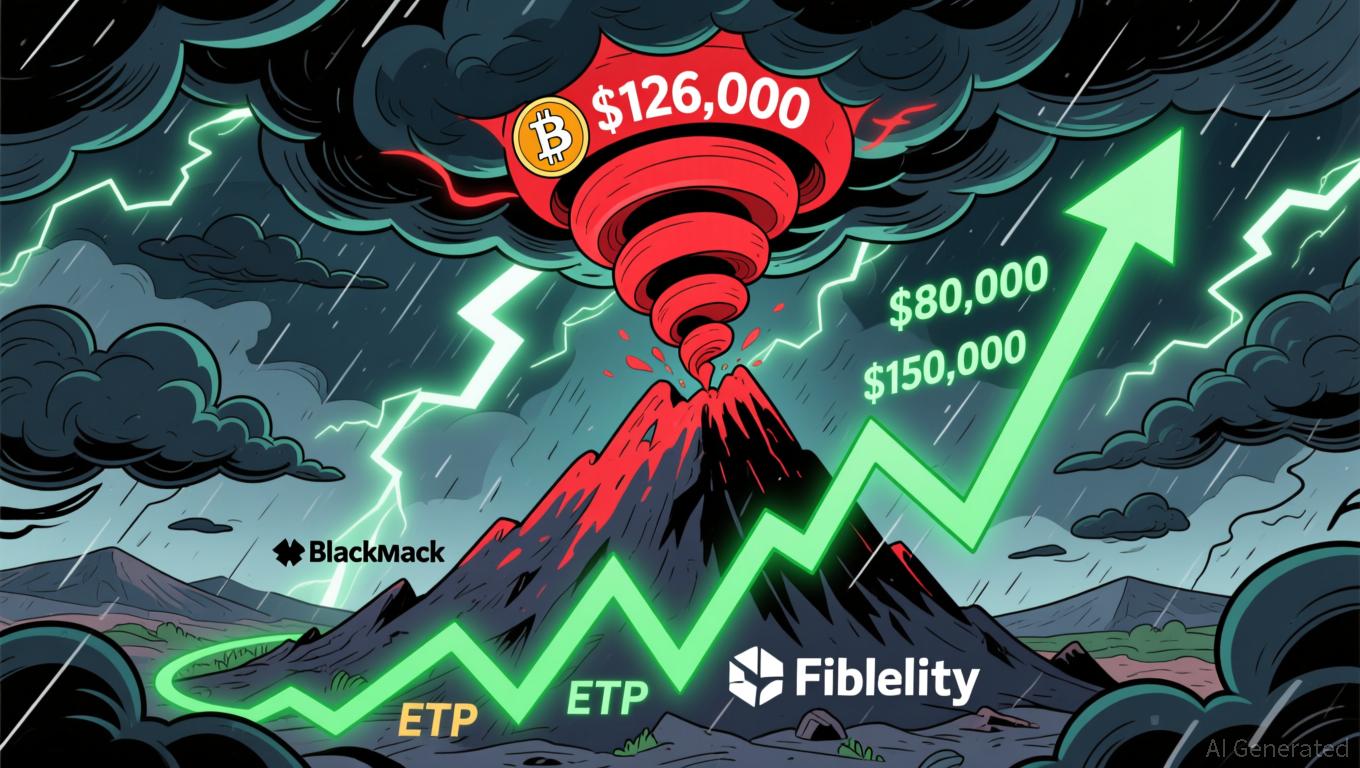The Impact of Artificial Intelligence on Contemporary Portfolio Management: Potential Benefits and Challenges
- AI redefines portfolio management with real-time analytics and dynamic asset allocation, shifting from static human-driven strategies to data-centric systems. - Generative AI tools like ChatGPT automate financial workflows, enabling hyper-personalized strategies and boosting business outcomes through optimized digital presence. - Risk modeling evolves via AI's pattern detection, but challenges persist in transparency and bias, requiring explainable AI frameworks and human oversight. - Institutions integr
How Artificial Intelligence Is Transforming Portfolio Management in 2026
By 2026, artificial intelligence (AI) has fundamentally altered the financial sector, revolutionizing the way investment portfolios are designed, managed, and optimized. AI now serves as the backbone of contemporary investment approaches, moving the industry away from traditional, manual methods toward agile, data-driven systems that emphasize efficiency, accuracy, and scalability. As AI-powered tools like ChatGPT and advanced machine learning models become embedded in financial operations, they bring both new opportunities and unique challenges that require careful oversight.
The Changing Landscape of Investment Strategies
Historically, portfolio management depended on manual analysis, historical trends, and infrequent adjustments, often resulting in slow responses to market changes. Today, AI-powered platforms utilize real-time data analysis, predictive algorithms, and continuous learning to swiftly adapt to market fluctuations and investor preferences. For example, hedge funds and automated investment advisors now employ sophisticated machine learning techniques to process massive amounts of information, enabling quick trades and highly tailored investment plans. The global market for robo-advisors is expected to expand rapidly by 2026, fueled by the demand for affordable and scalable investment solutions.

Active portfolio management has seen dramatic changes, with AI detecting new market trends and reallocating assets in fractions of a second. Even passive investment strategies are evolving, as AI automates the process of tracking benchmark indices, reducing both transaction costs and the potential for human mistakes. Additionally, the integration of environmental, social, and governance (ESG) factors has become more prevalent, with AI evaluating sustainability data to help align investments with ethical standards without sacrificing performance.
AI’s Influence on Risk Assessment
The approach to risk modeling has been transformed by AI’s ability to recognize intricate patterns and simulate potential crises. Advanced machine learning frameworks, such as multi-factor correlation models, group risk factors and filter out irrelevant data, allowing investors to focus on what matters most. These systems enhance risk evaluation by examining both past and current data, enabling proactive responses to signs of market stress.
Nevertheless, obstacles remain. The complexity and opacity of some AI systems can hinder transparency, while algorithmic biases and data quality problems may distort results. To tackle these issues, many organizations are implementing explainable AI (XAI) solutions and maintaining strong human oversight, ensuring that AI supports—rather than replaces—strategic decision-making.
Integrating ChatGPT and AI Tools into Financial Operations
Generative AI platforms like ChatGPT are streamlining financial processes by automating routine tasks and supporting more informed decisions. Sophisticated prompts now guide users through essential activities such as risk assessment, asset distribution, and scenario analysis, often presented in clear, structured formats like dashboards or tables. In one notable example from 2026, a commercial lending client of ROI Amplified experienced a 15% boost in inbound sales calls after enhancing their digital presence for AI-driven search, demonstrating the tangible business benefits of AI visibility.
Goldman Sachs’ GSXUPROD portfolio highlights the strategic advantages of AI, focusing on non-technology companies that have adopted AI to improve productivity and aiming to outperform major market indices. Similarly, leading financial institutions such as JP Morgan and Bank of America are leveraging AI for fraud prevention, customer support, and internal process optimization, showcasing the technology’s wide-ranging impact.
Navigating Risks and Shaping the Future
Despite its advantages, the integration of AI in finance brings significant risks. Ensuring the accuracy and reliability of data is crucial, as flawed information can lead to incorrect predictions. Overdependence on automation also poses the risk of diminishing human expertise, especially during periods of market instability. According to PwC’s 2026 AI outlook, successful implementation requires comprehensive organizational strategies that balance immediate objectives with long-term vision.
To address these challenges, financial firms must commit to responsible AI practices, including thorough testing, transparent protocols, and ongoing monitoring. The emergence of autonomous AI agents—capable of handling customer inquiries or developing prototypes—underscores the need for a human-centered approach, where AI enhances rather than replaces human judgment.
Conclusion
AI has moved beyond theoretical promise to become an essential component of modern portfolio management. By 2026, it enables sophisticated risk modeling, real-time portfolio adjustments, and highly personalized investment solutions. However, the true value of AI will be realized only through thoughtful integration, adherence to ethical standards, and continued human involvement. The financial industry’s ability to leverage AI’s strengths while managing its risks will shape the future of investment management.
Disclaimer: The content of this article solely reflects the author's opinion and does not represent the platform in any capacity. This article is not intended to serve as a reference for making investment decisions.
You may also like
Solana News Update: Meme Coin Craze and Its Hidden Dangers—Will Apeing Tactics Pay Off?
- Meme coin Apeing ($APEING) offers $0.001 whitelist tokens before public trading, emphasizing structured growth and utility to differentiate from speculative projects. - The 2025 crypto market sees rising meme coin interest amid Bitcoin's rebound, but faces risks like the $116M Balancer hack and Solana's price volatility. - Apeing's community-driven strategy mirrors Dogecoin's success, yet analysts caution against market manipulation and security vulnerabilities in high-risk altcoin investments. - Project

Bitcoin Updates Today: Conflicting Indicators for Bitcoin: Temporary Pullback or Extended Decline?
- Bitcoin trades near $80,000 after 30% correction from $126,000 high, amid $1T+ market value loss from geopolitical tensions and leveraged liquidations. - Binance delists GMT/BTC and ME/BTC pairs to comply with regulations, potentially tightening liquidity for niche crypto pairs. - Analysts split between bullish consolidation (ETF inflows) and bearish warnings (triple divergence, 50-week MA break) for short-term BTC trajectory. - Long-term forecasts range from $150,000–$225,000 (institutional adoption) to

The Growing Prevalence of Shovel-Ready Infrastructure Grants and Their Influence on Real Estate and Industrial Growth
- Shovel-ready grants in NY and PA are accelerating industrial development through infrastructure upgrades and land value appreciation. - Municipal partnerships reduce development risks, transforming underused sites like coal mines into competitive industrial hubs. - Programs like FAST NY and PA SITES have generated billions in private investment, creating 16,700+ jobs and boosting regional competitiveness. - Strategic infrastructure investments in transportation , utilities , and site readiness drive prem

Altcoin advancements surge while security concerns pose risks to the next major breakthrough in cryptocurrency
- Altcoin investors target AI-driven projects like Ozak AI (Phase 7 presale) and Digitap ($TAP) for utility-focused growth amid market uncertainty. - Ozak AI's DePIN architecture and Phala Network partnership highlight AI's role in optimizing crypto yields and financial predictions. - Security risks escalate as South Korea's Upbit suffers $36M Solana breach, echoing Trezor CEO's warnings about exchange vulnerabilities. - Institutional adoption grows with projects like BlockchainFX ($BFX) redistributing tra
